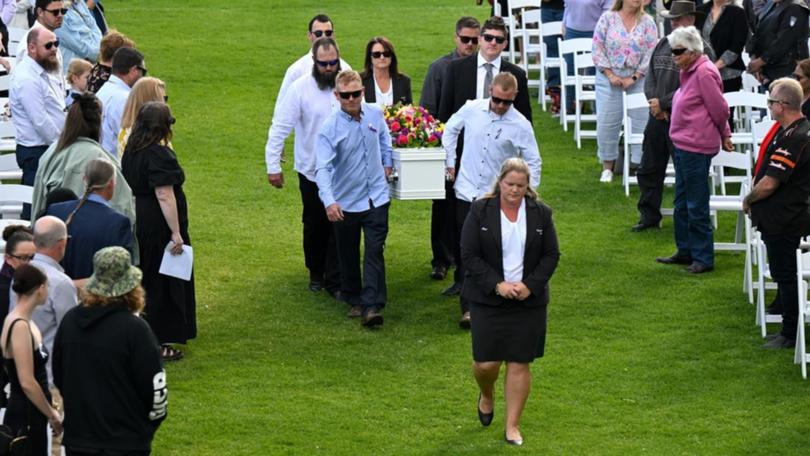‘It’s outrageous, it’s disgraceful’: Magistrate David Day on rate of domestic abuse in rural Australia

Magistrate David Day walks briskly into his country courtroom, facing a full day of domestic violence matters.
As he sits at the bench in his subdued black robe, Mr Day tells the police prosecutor he dealt with six bail applications the day before, including five alleged domestic violence perpetrators.
“One was a serious sexual assault matter from Parkes,” Mr Day says.
Sign up to The Nightly's newsletters.
Get the first look at the digital newspaper, curated daily stories and breaking headlines delivered to your inbox.
By continuing you agree to our Terms and Privacy Policy.His remark hangs in the silence of the courtroom for just a moment.
It has been exactly one week since Mr Day briefly heard the case of Daniel Billings, the 29-year-old accused of the domestic violence murder of childcare worker Molly Ticehurst in Forbes, central west NSW.
Billings, who was living in nearby Parkes, was free on bail facing three sexual assault charges and four counts of stalking Ms Ticehurst when he allegedly murdered her at her home in the early hours of April 22.
His bail - which had been granted by a court registrar in Dubbo - was formally revoked by Mr Day the morning after Billings was charged with murder.
Now Mr Day has another grim workload, with the dedicated domestic violence court list he oversees every Tuesday in Orange.
He has up to 50 matters, including sentencing, children’s cases and reviewing and varying apprehended violence order conditions.
A 42-year-old gardener pleads guilty to intimidating his ex-wife after a verbal argument by sending her a text message: “You are so lucky I didn’t punch you in the f***ing mouth”.
The man, who has stage four cancer, is placed under 12 months’ community supervision and a two-year apprehended domestic violence order is issued to protect the victim.
Mr Day says the offending is “far from trivial”.
“Domestic violence is a prevalent activity around the central west and around Orange,” he tells the man.
“[I did] six refusals of bail from over the weekend, five were domestic violence.
“It’s outrageous, it’s disgraceful.”
The atmosphere in the courtroom feels heavy with the moment of national reckoning on domestic and gendered violence, which only intensified after the alleged murder of Ms Ticehurst.
Her death followed the killings of Samantha Murphy, Rebecca Young and Hannah McGuire allegedly at the hands of men in Ballarat, regional Victoria.
Emma Bates, 49, was found dead at a property in Cobram, Victoria, the day after the Forbes incident.
The spate of deaths in under three months cast a spotlight on a long-standing crisis in country Australia, where the rate of DV is much higher than in the cities.
People in remote areas are 24 times more likely to be hospitalised due to domestic and family violence than their urban counterparts, Australian Institute of Health and Welfare data shows.
The situation is the result of deep structural problems like fewer first responders, a lack of specialist services and refuges, as well as long distances to hospitals, researcher Bridget Harris said.
The social fabric of small towns - where everyone knows everyone - can make reporting and escaping violence particularly difficult.
“In smaller communities it might be easier for the perpetrator to build alliances and try to deny, minimise, justify, excuse what’s happened, or to portray the victim as the perpetrator,” said Associate Professor Harris, who heads Monash University’s Gender and Family Violence Prevention Centre.
First Nations, migrant and refugee women are at greater risk of being misidentified as a perpetrator, often due to behaviour linked to trauma and mistrust of police and the justice system.
A victim-survivor’s income can be tied up in farming or family businesses, with traditional gender roles allowing perpetrators to frame financial abuse as simply managing the household, Dr Harris said.
Violence always spikes after disasters like floods, fires and droughts, when rural communities are encouraged to pride themselves on resilience.
“It can be really challenging when you’ve got people who are perpetrators involved in recovery efforts and they might be seen as a hero in the town,” she said.
“Then it’s incredibly challenging to disclose that that person has been violent and challenge that hero narrative.”
Amid outcry after the women’s deaths, there have been repeated calls for bail law reforms and pleas for men to call out controlling behaviour.
In NSW, there are demands for a royal commission into violence against women.
Frontline workers say practical action is urgently needed.
National Legal Aid is calling for $317 million annually to address increased need for their services, which help women and children navigate family law and apprehended domestic violence orders.
Use of duty legal services through NSW Legal Aid’s DV unit has surged by 61 per cent in the last year, in part due to their expansion into the regions.
“Domestic violence in the regions is at crisis levels,” NSW Legal Aid’s family and domestic violence acting director Anna Baltins told AAP.
Domestic Violence NSW, the peak body for services across the state, said budget comparisons showed the state government spent $200 million less than Victoria on addressing gendered abuse, despite its larger population.
After an emergency national cabinet meeting with state and territory leaders, the prime minister announced a $925 million package that will provide $5000 to women escaping violence.
Prime Minister Anthony Albanese said the Leaving Violence Program would not be the only initiative to address gendered abuse and it wasn’t a matter of “job done”.
Dr Harris said investment should focus on prevention, which is not usually politically popular because results are not seen in an election cycle.
Prevention can be through better resourcing of specialist services, trauma-informed training for police and judiciary and better awareness of risks to women when controlling behaviour is escalating.
“We need to be really conscious of ensuring that we are improving these systems so victim-survivors have confidence in using them,” Dr Harris said.
“Unfortunately ... if they have a bad experience with police or courts, they might not engage them again.”
Back in Orange, local state MP Philip Donato, who worked as a police prosecutor in western Sydney and regional NSW before entering politics, reflects on a heartbreaking fortnight in his electorate.
Mr Donato recalls being shocked by the amount of DV matters in the courts when he moved to the country 20 years ago.
He puts it down to several factors, including greater use of drugs and alcohol in the regions and fewer health and welfare services.
“It’s a statistic we should be ashamed of,” he says, preparing to attend Ms Ticehurst’s funeral the following day.
With the support of her family and friends Mr Donato is lobbying NSW Premier Chris Minns for greater protections for women, including electronic monitoring of violent perpetrators out on bail.
“The system is not working,” he says.
“There’s not enough protections afforded for victims of domestic violence, it seems to be skewed in favour of an accused.
“I haven’t seen, in my time, a movement as strong as it is now to push for reform.”
